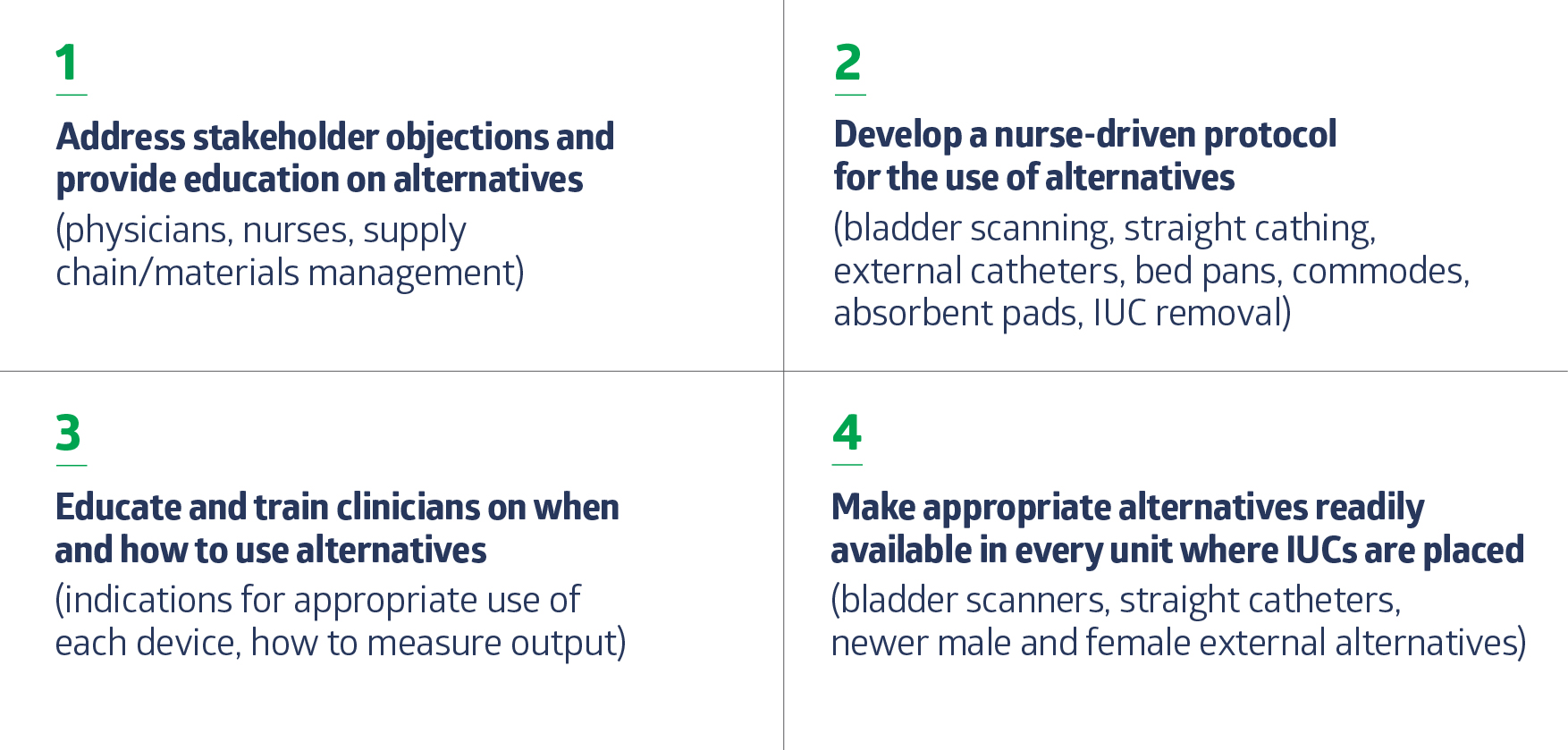Strategies for overcoming barriers to using IUC alternatives
Straight catheterization and external catheters need stakeholder buy-in.

Preventing catheter-associated urinary tract infections (CAUTIs) can be challenging, especially when you consider how often indwelling urinary catheters (IUCs)—or Foleys—are placed in patients. Each insertion creates a risk for infection. Did you know:
- More than 2.5 million unnecessary IUCs are used on patients in U.S. hospitals each year1
- More than 50% of patients in emergency departments (EDs) have IUCs placed, due to the assumption that all patients need to have hourly fluid intake and output (I&O) measured2
- Women are twice as likely than men to have an IUC inserted when not needed3
So how do you know when IUCs are necessary? There are six indications for IUC use, according to the Centers for Disease Control and Prevention.4 When a patient doesn’t have an appropriate indication, alternatives to IUCs are available. Yet many clinicians are not aware that they exist—just one barrier to implementing these options. Other barriers include competing priorities/time constraints, standing physician orders, nursing reluctance to change deep-seated care habits, lack of appropriate supplies and lack of nurse-driven protocols.
You can remove these obstacles with the right approach.
Use a 4-part strategy for success
It takes lots of collaboration and education—all with the goal of providing the best care to patients.

1
Address stakeholder objections and provide education on alternatives
- Physicians: Demonstrate the risks of IUCs and how patient safety and outcomes could be improved by reducing IUC use. Educate them on the American Nurses Association evidence-based tool for CAUTI prevention, which provides indications for using IUCs, indications for using IUC alternatives, algorithms for bladder scanning and straight cathing, and more4. Identify and develop a physician champion—preferably the key physician on the CAUTI prevention committee—who will lead the way to change practice. It’s also helpful to have a physician champion for each unit.2
- Nurses: Drive home the complications that can result from IUCs and that CAUTIs can be prevented by using alternative options. Educate them on devices such as bladder scanners and external catheters, making sure they understand that 24-hour urine output can be measured with non-invasive alternatives. Emphasize the importance of mobility for post-surgical patients who should be up and moving.
- Supply Chain/Materials Management: Highlight the benefit of standardizing products and using devices that cost less than an IUC tray. For example, one male external alternative and one female alternative can be selected, reducing SKUs within the system. Encourage them to collaborate with product representatives to ensure the best value, such as using bundles and kits.
Once you’ve obtained buy-in, you and other members of a multidisciplinary team can evaluate and select effective IUC alternatives.
“The team should include a clinician from every unit, leadership, educator, physician champion who can develop CAUTI prevention coaches, ICU manager and ED manager,” says Donna Matocha, Medline Manager of Clinical Resources – Acute Care. “They will be the ones who will advocate for the adoption and use of the devices.”
2
Develop a nurse-driven protocol for the use of alternatives
Typically, it takes five physician-driven steps for a catheter to be removed. IUCs often are in place without physician awareness and are not removed promptly when needed. Prolonged catheterization is the number one risk factor for CAUTI.5
30%–50%
of continued catheterization days are found to be unnecessary.5
Nurse-driven protocols enable nurses to make autonomous care decisions, simplifying appropriate catheter use and timely removal.
- Using an algorithm, the nurse determines whether an IUC is indicated for a given patient5
- If an IUC isn’t necessary, the nurse uses a bladder scanner to assess urination and bladder emptying. Next steps are determined according to whether the patient has urine retention and/or incontinence. Depending on results, the nurse uses a straight (intermittent) catheter, external catheter, bed pan, commode or absorbent pads that can be weighed to measure output.
- The nurse repeats the bladder scan every six hours and uses the ANA algorithm to determine next steps
As for catheter removal, a nurse-driven protocol enables nurses to evaluate whether an existing IUC is still indicated and, if not, remove the catheter without doctor’s orders.
3
Educate and train clinicians on when and how to use alternatives
If you’ve tried alternatives and they haven’t worked well, take a look at today’s devices:
- Bladder scanner: This device is used to assess bladder emptying and determine the next-step intervention for the patient.
- Intermittent catheter: This device with a soft, flexible tube that has tiny openings at the end is used for decompressing the bladder to drain urine via the urethra. The ANA CAUTI Prevention Tool recommends intermittent catheterization of patients with acute urinary retention as opposed to insertion of an IUC.4
“We are trained to do no harm. Less device days equals less risk for patients.”

Mary Pat Eble, MSN, RN
Medline National Clinical Product Specialist – Urology
- External catheters: A device for males collects and contains urine via tubing that relies on gravity to drain urine away from the penis. Recommended for accurate output, this product should not be used with patients who are restless or combative.2 An external female catheter conforms to the perineal area against the urethra. Newer versions are designed for a better and more comfortable fit, lower risk of pressure injury and more effective incontinence control.
4
Make external catheters and other appropriate devices readily available in every unit where IUCs are placed
Start with an assessment of your supplies:
- What IUC alternatives are already available?
- Are a sufficient number on hand?
- Are they stocked in all units that use IUCs or only some units?
When you’ve determined what you have and worked with the multidisciplinary team to decide what you need, include frontline staff in the selection of the actual products.
You’ll want to involve supply chain/materials management every step of the way so that you’re all on the same page regarding products, quantity needed, how often they’re replenished and where the products should be delivered.
Encourage supply chain staff to collaborate with their product representatives to ensure the best value. Once you’ve implemented use of the devices, ask staff to provide feedback.2 You’ll be well positioned to continually enhance protocols, practices and products.
Where to start
“To implement alternatives, it’s best to start on the units that have the higher usage of indwelling urinary catheters,” says Eble. “That may be a geriatric unit, not just the ICU. Units that have higher usage probably also have higher CAUTI rates.”
“Starting an initiative to reduce IUC use will take getting back to basics,” says Matocha. “Revisit your goal. Review what works and the alternatives you currently have. And with a lot of staff being new these days, you can start them off right. Then you can begin making headway.”
Key takeaway
More than 2.5 million unnecessary IUCs are used on patients every year, each one creating a risk for infection. Alternatives are available, yet barriers exist to implementing them. By using a four-part strategy, you can overcome objections, implement effective protocols and practices, reduce IUC use and help prevent CAUTIs. And what else? Increase patient safety, outcomes and satisfaction.
References:
- Institute for Healthcare Improvement. (2011, December). How-to guide: Prevent catheter-associated urinary tract infections. How-to Guide: Prevent Catheter-Associated Urinary Tract Infection | IHI – Institute for Healthcare Improvement
- Greene, L. (n.d.) Alternatives to the indwelling urinary catheter. CDC, HRET and STRIVE. CAUTI 103 (cdc.gov)
- Fakih, M.; Wolf, L.; and Schuur, J. (2013, September 10). The emergency department & catheter insertions. AHRQ. https://www.ahrq.gov/hai/cauti-tools/archived-webinars/ed-catheter-insertions-slides.html
- American Nurses Association. (2014, December 19). Streamlined evidence-based RN tool: Catheter-associated urinary tract prevention (CAUTI). Nursing World. https://www.nursingworld.org/~4aede8/globalassets/practiceandpolicy/innovation–evidence/clinical-practice-material/cauti-prevention-tool/anacautipreventiontool-final-19dec2014.pdf
- Meddings, J.. (n.d.) Appropriate use and prompt removal of indwelling urinary catheters. CDC, HRET and STRIVE. CAUTI 102 (cdc.gov)




